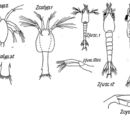Biology
provided by Arctic Ocean Biodiversity 2011
A common krill of the subarctic Atlantic and Pacific, and adjacent Arctic seas
- license
- cc-by-nc
- copyright
- Arctic Ocean Diversity
- author
- Alexei Pinchuk
- author
- Russ Hopcroft
Habitat
provided by Arctic Ocean Biodiversity 2011
Subarctic in deeper coastal waters and shelf breaks; Common in Arctic waters near Pacific or Atlantic inflows, uncommon in central basins; Undergo diel vertical migrations, spending daytime near bottom or to maxiamum of ~500 m, night-time in surface waters
- license
- cc-by-nc
- copyright
- Arctic Ocean Diversity
- author
- Alexei Pinchuk
- author
- Russ Hopcroft
Trophic Strategy
provided by Arctic Ocean Biodiversity 2011
Primarily herbivourous, may feed on detritous when food scarse; During open-water periods feed on phytoplankton when abundant (shifting to small zooplankton when phyoplankton less abundant); An important prey item for fish, birds, seals and whales
- license
- cc-by-nc
- copyright
- Arctic Ocean Diversity
- author
- Alexei Pinchuk
- author
- Russ Hopcroft
Comprehensive Description
provided by Arctic Ocean Biodiversity 2011
Transparent, yellowish if rich in lipids, females might develop blue hue when spawning; Eyes round, rostrum pointed, photophores red; Anntennae lack lappet, carapace without denticle; well-developed spine on 6th abdominal segment
- license
- cc-by-nc
- copyright
- Arctic Ocean Diversity
- author
- Alexei Pinchuk
- author
- Russ Hopcroft
Life Cycle
provided by Arctic Ocean Biodiversity 2011
Females lay several clutches of eggs (140 per brood on average) during spring; Females require repeated mating after each molt to form new egg clutches; Life cycles is typcial: eggs, nauplius, metanauplius, followed by several stages of feeding calytopsis, and furcillia larvae; Juveniles resemble adults, and molt regularly while growing to adulthood over the first year of life; Life expectancy not known, likely 1-2 years
- license
- cc-by-nc
- copyright
- Arctic Ocean Diversity
- author
- Alexei Pinchuk
- author
- Russ Hopcroft

